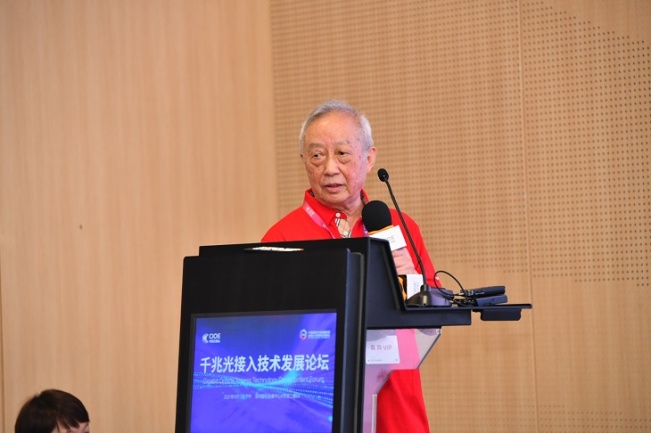Mao Qian: Broadband has a long way to go, and 10 Gigabit broadband is about to emerge

At the forthcoming "Optical Access Technology
Forum", Mao Qian, honorary director of the Optical Communication Committee
of the China Institute of Communications and chairman of the China FT Forum,
said that professional networks have a long way to go, and the development of
10 Gigabit broadband is about to emerge.
At the forthcoming "Optical Access Technology Forum",
Mao Qian, honorary director of the Optical Communication Committee of the China
Institute of Communications and chairman of the China FT Forum, said that
professional networks have a long way to go, and the development of 10 Gigabit
broadband is about to emerge.

Gigabit broadband, a long way to go
At present, my country has built the world's largest fixed
broadband network, and all cities above the prefecture level across the country
have achieved full coverage of optical fiber networks.
Data shows that the total number of fixed Internet broadband
access users reached 514 million, a year-on-year increase of 9.9%. The
country's rural broadband users increased by 10.75 million from the end of last
year, bringing the total to 153 million, a year-on-year increase of 8.4%. The
total number of fixed Internet broadband users with access rates of 100Mbps and
above reached 472 million, accounting for 97.4% of the total number of fixed
broadband users. The number of users with access rates of 1000Mbps and above is
16.04 million, accounting for 3.3% of the total number of fixed broadband
users.
Broadband acceleration is a significant feature of the rapid
development of the modern information society. At present, gigabit broadband
networks have entered large-scale commercial use, and basic telecommunications
companies are accelerating the deployment of gigabit networks based on 10G PON
technology.
According to OVUM statistics, 234 operators in 57 countries
around the world have released gigabit broadband construction plans, committed
to building a solid foundation for the digital transformation of the economy
and society.
"Gigabit optical bandwidth includes multiple aspects of
home broadband, industry, and urban applications." Mao Qian pointed out
that high-end and large-scale online games require high-bandwidth and
low-latency access to ensure that the gigabit optical bandwidth can be
increased. Streaming social media has extremely high requirements for user
interaction. High-definition, high-fidelity audio and video interaction
requires the network to have the support of large bandwidth, low latency and
high stability. Gigabit network is an inevitable choice for the ultimate social
experience of streaming media. . Online education, home office, online meeting,
telemedicine, smart home, safe city, smart manufacturing, etc. all require a
gigabit broadband platform to have a good user experience.
On March 24 this year, the Ministry of Industry and
Information Technology issued a notice on the "Dual Gigabit Network
Coordinated Development Action Plan (2021-2023)". Someone in the industry
has proposed that 5G will replace home broadband. Mao Qian did not agree with
this view. He said, “In fact, the two are not a substitute. The high-speed,
flexible, mobile and home-wide stable, reliable and large bandwidth of 5G are
used in different scenarios. They can (and should) complement each other,
develop coordinated development, and keep pace with each other. This is also
the general trend. ."
"Fixed-mobile synergy, complementary advantages."
Mao Qian pointed out that the Gigabit optical network has the advantages of
large transmission bandwidth, strong anti-interference, and microsecond-level
connections in indoor and complex environments, and the high flexibility of 5G
networks, enhanced mobile, and The advantages of big connection, in the long
run, the high-quality development of home broadband and the cooperation of 5G
will be the information foundation that supports the innovation and prosperity
of various industries. At the same time, PON technology can support the rapid
deployment of 5G. "
"Fixed broadband access networks are supported by 10G
PON access technology, which can bring gigabit broadband access capabilities.
However, when the Gigabit network coverage and applications are further
upgraded, they are still somewhat powerless." Mao Qian believes that
gigabit broadband Although it has been achieved, there is still a long way to
go for future development.
10 Gigabit broadband, ready to come
As people's living standards continue to improve and become
more intelligent, online office/meeting/work interaction, etc., put forward
more and higher requirements on the network environment, and 10 Gigabit
broadband is about to emerge. Mao Qian predicts that the initial 10 Gigabit
broadband will be mainly deployed in campus/enterprise/Internet cafes/key
customer scenarios, and then it will develop into home broadband.
In foreign countries, Google proposed a plan to deploy 10
Gigabit broadband in 2014; South Korea also proposed to promote 10 Gigabit
broadband services in 2018; Japan’s NTT East/West launched 10 Gigabit fiber
access services in early 2020 with download speeds. It can reach 1.25GB per
second, and the services provided are symmetrical, with both the upstream and
downstream bandwidth rates being 10Gbps, and the monthly fee is about 380 yuan.
Domestically, many explorations and attempts have been made
in 10 Gigabit broadband. In 2012, Jishi Media was a complete solution for the
overall solution of 10 Gigabit fiber-to-the-home I-PON technology. In 2019,
China Telecom proposed to accelerate the progress of 10 Gigabit optical
networks into commercial buildings and industrial parks on the basis of the
full coverage of Shanghai's gigabit broadband network. At the same time,
various technologies supporting 10 Gigabit broadband are gradually maturing,
and 10 Gigabit broadband is visible.